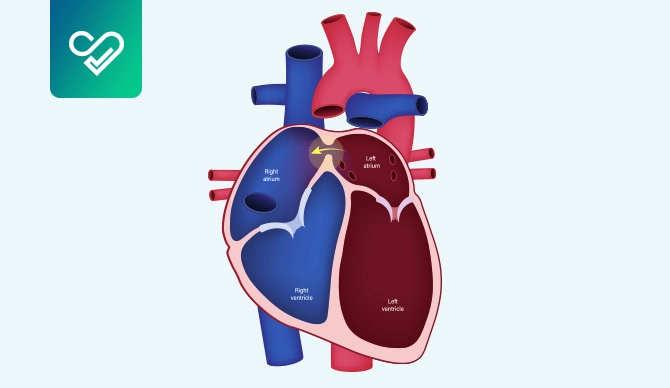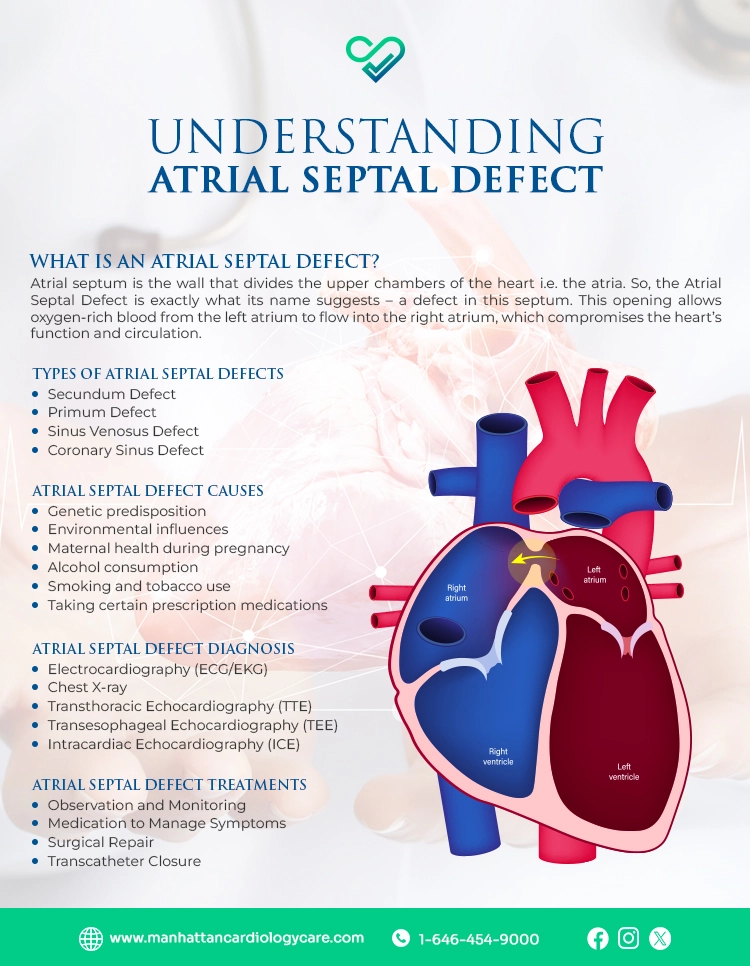Table of contents
What is an Atrial Septal Defect?
Atrial septum is the wall that divides the upper chambers of the heart i.e. the atria. So, the Atrial Septal Defect is exactly what its name suggests – a defect in this septum. This opening allows oxygen-rich blood from the left atrium to flow into the right atrium, which compromises the heart’s function and circulation.
Types of Atrial Septal Defects
Atrial Septal Defects manifest in various forms – defined and differentiated by their location in the atrial septum, the four main types are:
- Secundum Defect: This is the most common type, occurring in the central part of the atrial septum. It involves a deficiency in the septum’s central region, allowing the blood to flow between the atria.
- Primum Defect: A little less common than the secundum defect, the primum defect involves an opening in the lower part of the atrial septum, near the atrioventricular valves. And it’s often associated with other congenital heart defects.
- Sinus Venosus Defect: This type of atrial septal defect is located near the junction of the superior vena cava and the right atrium. It involves an abnormal connection between the right atrium and the venous system, potentially leading to blood flow abnormalities.
- Coronary Sinus Defect: Being almost rare in comparison to the other types, this type of atrial septal defect involves an opening near the coronary sinus, which drains blood from the heart muscle. It can lead to abnormal blood flow patterns and may require specialized treatment approaches.
Each type of atrial septal defect presents its unique challenges and considerations, which eventually influences the treatment decisions and the outcomes.
Conditions Associated with Atrial Septal Defect
Atrial septal defect often coexists with other congenital heart defects, including but not limited to:
- Patent Foramen Ovale (PFO)
- Ventricular Septal Defects (VSD)
- Mitral Valve Prolapse (MVP)
- Pulmonary Stenosis
Moreover, the associated genetic disorders include:
- Holt-Oram Syndrome
- Down Syndrome
- Thrombocytopenia-Absent Radii (TAR) Syndrome
Symptoms of Hole in Heart
The early identification of ASD heart is an important aspect of its effective management. The symptoms of hole in heart may include:
- Fatigue
- Shortness of breath
- Recurrent respiratory infections
- Heart palpitations
- Swelling in the arms and legs
- Stroke (in severe cases)
Atrial Septal Defect Causes
While the exact atrial septal defect causes aren’t completely understood, mostly they’re caused by gene alterations that occur before a child is born. There are specific gene mutations like NKX2.5/CSX and TBX5 that are linked to ASD.
Certain factors can increase the risk of a parent giving birth to a child with a heart problem, which include:
- Genetic predisposition
- Environmental influences
- Maternal health during pregnancy
- Alcohol consumption
- Smoking and tobacco use
- Taking certain prescription medications
Atrial Septal Defect Diagnosis
Accurate atrial septal defect diagnosis in a timely manner is very important and can be achieved through:
- Electrocardiography (ECG/EKG): This non-invasive test records the electrical activity of the heart. While it can’t directly diagnose an ASD heart, it helps identify irregular heart rhythms and other abnormalities that may indicate the presence of a defect.
- Chest X-ray: A chest X-ray provides images of the heart and surrounding organs. It may reveal enlargement of the heart or changes in lung blood flow, which can be suggestive of a hole in heart. However, it’s not definitive for diagnosing ASD heart.
- Transthoracic Echocardiography (TTE): TTE uses sound waves to create images of the heart’s structure and function from outside the body. It’s a primary diagnostic tool for ASDs, allowing doctors to visualize the defect and assess its size, location, and impact on blood flow.
- Transesophageal Echocardiography (TEE): TEE involves inserting a specialized probe into the esophagus to obtain clearer and more detailed images of the heart. It’s particularly useful for visualizing ASDs that may be obscured by lung tissue or other structures during TTE.
- Intracardiac Echocardiography (ICE): ICE involves inserting an ultrasound probe directly into the heart through a catheter. It provides real-time images of the heart’s interior, allowing for precise assessment of ASDs and guiding interventional procedures such as catheter-based closure.
Atrial Septal Defect Treatments
There are various Atrial Septal Defect treatment options available depending on the severity of the defect and the patient’s overall health. These options include:
- Observation and Monitoring:
In cases where the hole in heart is small and not causing significant symptoms or complications, a strategy of observation and regular follow-up appointments may be recommended. Monitoring helps track the progression of the defect and ensures timely intervention if needed.
- Medication to Manage Symptoms:
Certain medications may be prescribed to alleviate atrial septal defect symptoms, such as fatigue, shortness of breath, or heart palpitations. These medications aim to improve quality of life and manage any related complications.
- Surgical Repair:
Surgical repair involves open-heart surgery to close the atrial septal defect using patches or sutures. This approach is typically recommended for larger defects or when other atrial septal defect treatment options are not suitable. Surgical repair aims to prevent complications and restore normal heart function. - Transcatheter Closure:
Transcatheter closure is a minimally invasive procedure performed by interventional cardiologists. It involves inserting a catheter into a blood vessel and guiding it to the heart to deploy a closure device, such as a septal occluder, to seal the hole in heart. This procedure is often preferred for smaller to moderate-sized defects and offers faster recovery times compared to surgery.
When To See a Doctor?
Prompt medical attention is necessary if you experience any concerning symptoms or have a family history of congenital heart defects. At Manhattan Cardiology Care, our team of experts are ever-ready to provide comprehensive evaluations and tailored treatment plans.
– Disclaimer –
This blog is for informational & educational purposes only, and does not intend to substitute any professional medical advice or consultation. For any health related concerns, please consult with your physician, or call 911.


